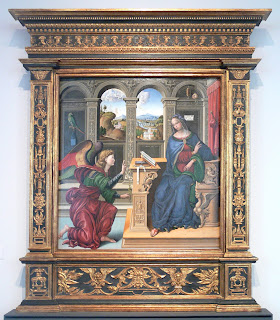 |
| Rosemary Coonie, 1988, Jim Lane Despite the title and the portrait-like pose, this is just an animal, not a portrait. |
When people talk about portraits, the obvious image that comes to mind is the typical head and shoulders pose popularized around the time of the Renaissance and since engraved in stone by portrait photographers. In more recent years, giving credit where it's due, the portrait artists behind the camera have loosened up somewhat, broadening their repertoire of poses to include even full-length depictions, though their work still tends to follow tried and true formulas--albeit new formulas. However, the second most popular subject for portrait painters is that of pets. Painting pets and simply painting animals, though related, are two different undertakings, as different as oils and acrylics. A pet has a well-known, look and personality. An animal has neither. Wildlife painters don't have to worry about getting the nose "just right."
 |
| Felina and Jonathan, 1990, Jim Lane. Both the noses required foreshortening. |
Over the years, I've probably drawn and painted almost as many pets as people, and just for the record, one is pretty much as demanding as the other. Of course the subject of the pet portrait seldom complains if there's a nose problem, but you can bet your palette knife their owners will. Likewise, the pitfalls in pet painting and people painting are quite similar. Naturally, except for portraits of goldfish and boa constrictors, the hair is critical and often the most difficult feature to capture. Often, however, the artist will be so concerned with the facial features the fur coat is treated as just a nuisance afterthought. Anyone who has ever painted the feminine gender knows the folly of treating the tresses as trivial. Male or female, the same applies to dogs and cats, the most commonly painted pets (though glistening horsehide is much more difficult).
The other most common pitfall is the feature mentioned earlier--the nose. One of the most troublesome parts of the human face is the nasal protrusion. First of all, it's likely the least attractive part of the face, and the one in which the Modern Art mantra, "less is more" was never more valid. More often than not, it calls for some degree of foreshortening, which very often baffles beginning artists and all too often antagonizes the more experienced as well. With most pets (goldfish and boa constrictors aside) the painter encounters noses of enormous variance in length ranging from a few millimeters to several inches. Add to this the critical importance of the head angle in determining just how long to depict the nose, and it's enough to send a painter scurrying back to the relative safety of the human face.
 |
| The Marriage of Giovanni Arnolfini and his Wife, 1434, Jan van Eyck. The dog is show in more detail below, left. |
 |
| The Arnolfini Marriage (detail) |
My definition of a portrait is that it's any depiction of a proper noun--a specific person, place, or thing important enough for someone to pay an artist to render it. Though pet owners would probably cringe at my counting their four-legged family member as a "thing," the term has the important attribute of simplifying the definition to include a "miscellaneous" category. Historically, it's hard to accurately place the first true "pet" portrait among the thousands of animals artists have rendered on canvas over the centuries, but we could probably be fairly safe to suggest Jan van Eyck's Marriage of Giovanni Arnolfini and his Wife (above) from 1434 as a good starting point. Historically, it's also one of the first portraits painted in oil, which may or may not be a coincidence with regard to the dog. The puppy-dog is rendered in very low contrast so as not to "steal the show" by literally upstaging the newlyweds. It has an almost cat-like face. Art historians disagree as to whether it was an actual pet or merely a symbol of marital fidelity--man's (and woman's) best friend.








































.jpg)






